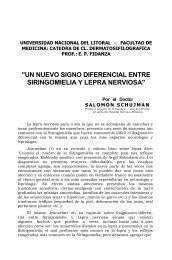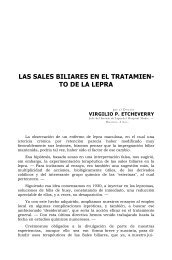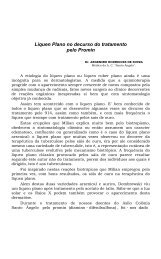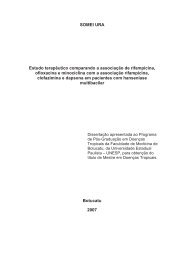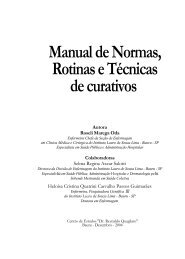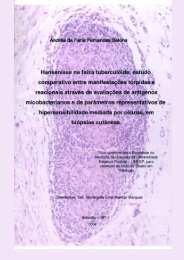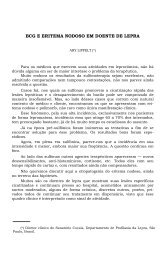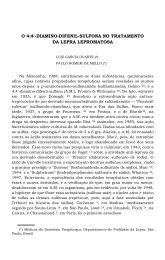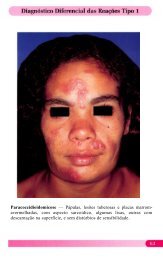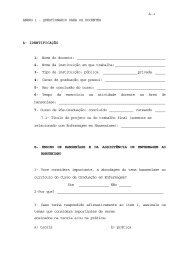Phagocytic Myeloperoxidase in Leprosy Pathogenesis
Phagocytic Myeloperoxidase in Leprosy Pathogenesis
Phagocytic Myeloperoxidase in Leprosy Pathogenesis
You also want an ePaper? Increase the reach of your titles
YUMPU automatically turns print PDFs into web optimized ePapers that Google loves.
68, 1^ Correspondence<strong>Phagocytic</strong> <strong>Myeloperoxidase</strong> <strong>in</strong> <strong>Leprosy</strong> <strong>Pathogenesis</strong>To THE EDITOR:ft is well known that a causative agent ofleprosy, Mycobacterium leprae, survivesand multiplics <strong>in</strong> cells of the mononuclearphagocyte l<strong>in</strong>e (MPL). MPL cells act as <strong>in</strong>itiatorsand regulators of the immtme responseand they are <strong>in</strong>volved <strong>in</strong> nonspecificrcsistance and antimicrobicidal activities. Ina view of improvement and development ofnew methods for the prevcntion and therapyof leprosy, a detailed study of the mechanismsofM. leprae persistencc <strong>in</strong> MPL cellsseems to bc urgem.Today a lot of researchers devote themselvesto study<strong>in</strong>e. myeloperoxidase (MP)of phagocyt<strong>in</strong>g cells, especially <strong>in</strong> chronic<strong>in</strong>fectious and granulomatous diseases,s<strong>in</strong>ce it is known that the acquired or hereditarydeficit of MP activity might favor thedevelopment of chronic <strong>in</strong>fectious diseases,<strong>in</strong>fectious complications of chronic <strong>in</strong>fectiousdiseases or granulomatoses.Accord<strong>in</strong>g to prescnt-day conceptions,acid hydrolases destroy only those bacteria<strong>in</strong> phagolysosomes which have been killcdby the MP system, nonenzymatic cationicprote<strong>in</strong>s, lysozyme and lactoferr<strong>in</strong> ()).Decrcased MP activity of neutrophils ofperipheral blood has been observed <strong>in</strong> patientswith chronic myeloleukosis and subleukemicmyelosis. In this group there wasa high percent of the cases with <strong>in</strong>fectiouscomplications (2). With strongly <strong>in</strong>sufficientactivity of MP, MPL cells are not capable ofkill<strong>in</strong>g candida, stztphylococci and variousgram-neg,ative microorganisms (). Low<strong>in</strong>dices o—f MP activity of peripheral bloodphagocytes are found <strong>in</strong> patients with <strong>in</strong>filtrateddermatophytoses of the scalp C) andpatients with chronic tonsillitis ('). The dataobta<strong>in</strong>ed suggest that the levei of MP activityof MPL edis might be a reliable criterionfor the assessment of their phagocyticability.In M. leprae-<strong>in</strong>fected armadillos Al. leptoewere absent <strong>in</strong> macrophages with highactivity of MP, and, contrary, macrophageswith low MP activity conta<strong>in</strong>ed numerousM. lepme <strong>in</strong> their cytoplasm (8)•We carried out electron cytochemical <strong>in</strong>vestigationsof sk<strong>in</strong> granulomas from lepromatousleprosy patients and found thatmacrophage cytoplasm with low MP activityconta<strong>in</strong>ed clusters of <strong>in</strong>tact M. lepraeand, contrary, <strong>in</strong>tensive lysis of Al. lepraeWaS observed <strong>in</strong> macrophages with highMP activity e). Our long-term (over 14years) obscrvations on the possible relationshipbctween the terms of appearance andstability of cl<strong>in</strong>icai improvement and activityof phagocytic MP could establish astrong association between the rate of MPactivity <strong>in</strong> <strong>in</strong>acrophages of sk<strong>in</strong> lepromas(as obscrved at the patient's admittance)and the time of appearance of the first signsof cl<strong>in</strong>icai improvement and stability ofreg,ress. A high levei of MP activity <strong>in</strong> granumamacrophages strongly correlatedwith the fast elim<strong>in</strong>ation of Al. leprae andLhe highest peak of effectiveness of therapyadm<strong>in</strong>istered. Low activity of macrophageMP was correlated with the slow regrcss ofthe disease and risk of relapse (`').Further, the goal was sought to f<strong>in</strong>d acorrelation between the <strong>in</strong>tensity of phagocyticresponses and MP activity <strong>in</strong> experimentson mice subject to ai] <strong>in</strong>duced decrease<strong>in</strong> MP activity <strong>in</strong> MPL cells, as well as toelucidate whether it is possible to simulate aprocess of persistence of pathogenic mycobacteria(Al. leprae and M. tubetrulosis)<strong>in</strong> MPL cens under the above conditions.With this atm <strong>in</strong> m<strong>in</strong>d, the follow<strong>in</strong>gtasks should be solved: to evolve a methodof decreas<strong>in</strong>g the activity of phagocytic MPand to def<strong>in</strong>e optimal agent concentrationthat would not affect cell ultrastructure.ft is well known that one of the ma<strong>in</strong>functions of MPL is to b<strong>in</strong>d hydrogen peroxideprevent<strong>in</strong>g its cellular accumulation;the enzyme therewith loses its activity. Alith<strong>in</strong>gs considered, wc attempted to reduceMP activity <strong>in</strong> MPL cens by saturat<strong>in</strong>gthem with hydrogen peroxide solution.In order to obta<strong>in</strong> peritoneal macrophages(PM), mice were stimulateci bymeans of <strong>in</strong>traperitoneal (i.p.) <strong>in</strong>jection of2% peptone casem n solution. Two hr afterstimulation and 1-2 hr before Al. leprae <strong>in</strong>-
72^ International Journal af <strong>Leprosy</strong>^ 2000TABLE 1. Coutas qf M. leprae permonse fool pad <strong>in</strong> animais receiv<strong>in</strong>g0.03-0.05 of 0.6% kvdrogen pero.vide<strong>in</strong>to the foot pad 1-2 lir bef<strong>in</strong>-e <strong>in</strong>oculationof 1 x M.leprae."Mos. afterM. /eprae cotim per mouse foot pael x 10''<strong>in</strong>oculation^Test mice^Control l<strong>in</strong>ce3 27.19 ± 2.3" 9.48 ± 1.75 101.6 ± 5.8" 3.71 ± 0.367 378.0 ±- 9.8" 38.17 ± 4.19 109.0 -± 7.8" 12.1 ± 1.211 58.1 + 6.2" 10.0 ±- 1.6Mice received til. leprae from a lepromatous leprosypatient which had been passed three times <strong>in</strong>mice. Data are given as mean + SEM.: N = 6.Statistical analysis = Student's t test, p = 0.05.Fio. 1. Electron micrographs of peritoneal macrophages(PM) of test (a) and control (h) mice 6 clays aiterAI. leprae (ML) <strong>in</strong>oculation; ps = pseudopodia, v =vacuoles (uranil acetate and lead citrate sta<strong>in</strong>; bar = 0.5mm).oculation the mice were <strong>in</strong>jected i.p. withtest solutions of hydrogen peroxide (0.3%,0.6% and 1.0%) at a dose of 2 ml. Micewere <strong>in</strong>oculated i.p. with 1 x 10' organismstuberculosis obta<strong>in</strong>ed from patientswith pulmonary tuberculosis and M. lepmepassed on mice were suspended <strong>in</strong> 1 ml ofsalt solution). The mice were sacrificed at 2hr, 1, 2, 3, 4, 5, and 6 days after <strong>in</strong>oculation.PM activity was assayed electron microscopicallyand cytochemically as well as <strong>in</strong>an absorption test.The experimental data showed that <strong>in</strong>mice <strong>in</strong>jected i.p. with the experimentallychosen 0.6% concentration of hydrogenperoxide at a dose of 2 ml, MP activity <strong>in</strong>MPL cells was significantly decreasedwith<strong>in</strong> 6 clays, with a simultaneous reduction<strong>in</strong> phagocytic activity. Electron microscopyof H,0,-treated PM at 6 claysshowed numerOus-mycobacterial Mis with<strong>in</strong>tact ultrastructure (Fig. la). In controlsamples, mycobacteria were completelylysecl <strong>in</strong> 2-3 days (Fig. lb). Initial <strong>in</strong>clicesof PM absorption capability (phagocytic <strong>in</strong>dexand phagocytic cotim) markedly <strong>in</strong>creased,but 3 clays afterward they leveledoff and approached control <strong>in</strong>clices.A study of the ultrath<strong>in</strong> structure of PMshowed that a drop <strong>in</strong> activity of MP 2-3clays after the mice were <strong>in</strong>oculated was accompanieclby a significant clecrease <strong>in</strong> thenumber o{ PM pseudopodia and their Ilatten<strong>in</strong>g(macrophages became round) as well asdisturbed lysosome-phagosome fusionThus, a s<strong>in</strong>gle saturation of MPL censwith a 0.6% solution of hydrogen peroxidecauses reduced MP activity <strong>in</strong> phagocytes;hence, result<strong>in</strong>g <strong>in</strong> long-term persistence ofpathogenic organisms (Al. tuberculosis andM. leprae) <strong>in</strong> their cytoplasm.Based on the above <strong>in</strong>vestigations andconsider<strong>in</strong>g the actuality of develop<strong>in</strong>g anoptimal leprosy model and identification offactors favor<strong>in</strong>g mycobacterial persistence<strong>in</strong> host cells, we tried to improve Shepard'stechnique by selectively act<strong>in</strong>g on the MPsystem of phagocytes. For this purpose, 1-2hr before M. leprae <strong>in</strong>oculation the micewere given a 0.6% freshly prepared solutionof hydrogen peroxide at a dose of0.3-0.5 ml per foot pad. A s<strong>in</strong>gle <strong>in</strong>jectionof hydrog,en peroxide resulted <strong>in</strong> a more <strong>in</strong>tensivemultiplication of leprosy bacilli <strong>in</strong>Lhe mouse foot pads as compared with standardmethods of <strong>in</strong>oculation (Table 1) and ageneralization of the <strong>in</strong>fection (M. lepraewere seen <strong>in</strong> pr<strong>in</strong>t smears of lung andspleen tissue of mice) (Table 2). Electron
68, 1^ Correspondence^ 73TABLE 2. AFB iii pr<strong>in</strong>t smears of <strong>in</strong>ternalorgans of mire <strong>in</strong>oculated with 1 x 10'M. leprae <strong>in</strong> the foot path"Internai^Mouseorgans^groupLiver^TestControlKidney TestPresence of^lepra('3^5^7^9^11mos. mos. mos. mos. mos.Control^-^-Lung^Test^+++^+Control^-^-Spleen 'fest^ ++^+++ ++Control"Mycohacteria <strong>in</strong> the <strong>in</strong>ternai organs were estimatedas follows: = AFB/lield; + = 1-20 AF13/lield, ++ =20-50 AFB/lield, +++ = numerous AFB/lield.cytochemistry demonstrated low activity ofMP <strong>in</strong> phagocytic cells, suggest<strong>in</strong>g an importantrole of the MP system of phagocytes<strong>in</strong> the mycobactcrial kill<strong>in</strong>g andpathogenesis of leprosy (').Our studics provide an opportunity for adirected altcration of phagocytic activity ofMPL cells. A proposed approach to <strong>in</strong>ducephagocytic <strong>in</strong>sufficiency is similar to themechanism of human immunodeficiencies<strong>in</strong> a =bei- of chronic <strong>in</strong>fectious and <strong>in</strong>flammatorydiseases, offer<strong>in</strong>g strong possibilitiesfor scarches and screen<strong>in</strong>g immunocorrectiveagents of selective effect on bactericidalphagocytic system to compensatefor MPL <strong>in</strong>sufficiency.—Alexander K. Maslov, M.D.<strong>Leprosy</strong> Research InstituteOstrovsky pas.3Astrakan 414057, RussiaREFERENCES1. DRA(;()NERErsKy, V. D. and BAzitoRA, Y. 1. Assessmentof bactericida' system of polymorphonuclearleucocytes <strong>in</strong> patients with chronic tonsillitis.Laboratornoye Delo. 11 (1986) 649-652.GUSEVA, S. A., TislictIENK(), L. M. andGAIDUKOVA, S. N. <strong>Myeloperoxidase</strong> activity and<strong>in</strong>fectious complications: a relationship <strong>in</strong> myeloproliferativedisorders. Archiv Patologii 1 (1988)52-55.3. HAMAZINA, O. Sil. Assessment of myeloperoxidaseactivity <strong>in</strong> patients with dermatophytosesaga<strong>in</strong>st the background of immune therapy. Abstractsof 6th All-Russian Congress of Dermatologistsand Venerologists M. (1989) 356-357.4. MAsi.ov, A. K. A method of simulation of macrophagedefect: Patent No 2105352. Discoveries Inventions5(1988).5. MAsi.ov, A. K. and JuscENK0, A. A. Assessmentof functional activity of leprous macrophages.Archiv. Patologii. 11 (1988) 51-54.6. MAsi.ov, A. K. and JuscENK0, A. A. A method forprediction of leprosy relapse: Author's CertilicateNo 1636717 (USSR). Discoveries Inventions 11(1991) 122.7. MASI.OV, A. K. and KM.YANINA, O. V. A methodof simulation of leprosy <strong>in</strong>fection. Patent No.102482. Discoveries Inventions 2(1998).8. McKEENER, P. E., WALs0, G. P., SToRRs, E. E. andBALENTINE, J. D. Electron microscope of peroxidaseand acid phosphatase <strong>in</strong> leprous and un<strong>in</strong>fectedarmadillo macrophages: a macrophage subpopulationconta<strong>in</strong>s peroxisomes and lacks bacilli.Aro. J. Trop. Med. Hyg. 27 (1978) 1019-1929.9. PIGAREVSKY, V. E. The new trend <strong>in</strong> the teach<strong>in</strong>gon phagocytosis and nonspecilic resistance.Archiv Patologii 2 (1977) 84-94.10. UCHITEI., I. YA. Macrophages <strong>in</strong> immunity. M.Medic<strong>in</strong>e. 1978,199 pp.





